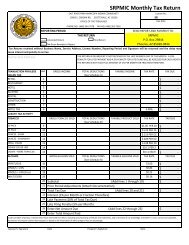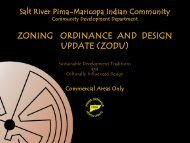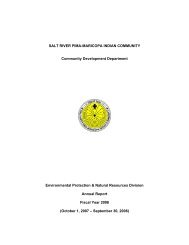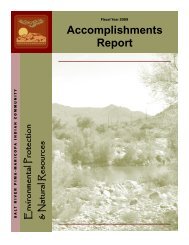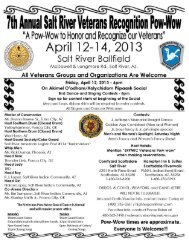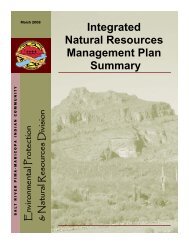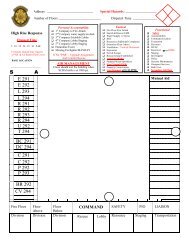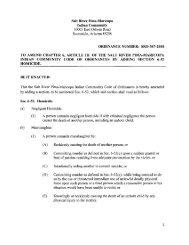SRPMIC General Plan - Salt River Pima-Maricopa Indian Community
SRPMIC General Plan - Salt River Pima-Maricopa Indian Community
SRPMIC General Plan - Salt River Pima-Maricopa Indian Community
You also want an ePaper? Increase the reach of your titles
YUMPU automatically turns print PDFs into web optimized ePapers that Google loves.
Sustainable <strong>SRPMIC</strong> . . . <strong>Plan</strong>ning for Generations<br />
PREFACE<br />
Executive Order of President Rutherford B. Hayes established the <strong>Salt</strong> <strong>River</strong><br />
<strong>Pima</strong>-<strong>Maricopa</strong> <strong>Indian</strong> <strong>Community</strong> (<strong>SRPMIC</strong>) for the <strong>Pima</strong> and <strong>Maricopa</strong> people<br />
on June 4, 1879. Originally the land area was extensive. The <strong>Community</strong> size<br />
was dramatically reduced when non-<strong>Indian</strong> settlers objected to the <strong>Indian</strong>s<br />
having so much land.<br />
The <strong>Community</strong>’s traditional way of life was changed through the years by<br />
politics and lack of water. Despite agreements and court decisions, water was<br />
diverted from tribal farms making farming nearly impossible. The Dawes Act of<br />
1910 attempted to replace the centuries old system of family farms and individual<br />
allotments of land. These allotments were divided into 10<br />
acres below the Arizona Canal and 20 acres of<br />
secondary land above the canal, with the 20-acre parcels<br />
having no rights to irrigation water.<br />
To regain some control over its land on June 15, 1940,<br />
the <strong>SRPMIC</strong> adopted the <strong>Indian</strong> Reorganization Act.<br />
Over the next approximately 60 years, it established a<br />
sophisticated system of government, launched<br />
successful enterprises, and began rebuilding the<br />
<strong>Community</strong>.<br />
The <strong>SRPMIC</strong> has a long history of conducting and<br />
implementing planning efforts. It was discovered that<br />
during the early period of the <strong>SRPMIC</strong>’s history various forms of “<strong>Community</strong><br />
<strong>Plan</strong>ning” existed. These ranged from water committees to social functions<br />
undertaken by private organizations and religious groups. A more formal<br />
approach was evidenced in the meetings held at the old <strong>Community</strong> Hall on<br />
matters dealing with agriculture, law and order, and future use of <strong>Community</strong><br />
lands.<br />
In the 1950s, the <strong>Community</strong> initiated a more formal approach to “<strong>Community</strong><br />
<strong>Plan</strong>ning” by utilizing private and public agencies in preparing a direction for<br />
growth, economically and physically. With the assistance of a private consultant,<br />
the <strong>Community</strong> Council adopted a <strong>General</strong> Development <strong>Plan</strong> in the late 1960s.<br />
The 1970 <strong>SRPMIC</strong> <strong>General</strong> Development <strong>Plan</strong> documented the past efforts and<br />
provided guidance for future growth around a central theme “Looking Ahead.”<br />
The 1978 <strong>General</strong> Development <strong>Plan</strong> Update included a growth factor by<br />
requiring periodic review and allowing for amendments to reflect the changing<br />
times and priority of needs. The 1983 <strong>General</strong> Development <strong>Plan</strong> Update<br />
indicated major changes occurring and focused on the general direction for<br />
development of <strong>Community</strong> lands.<br />
Major <strong>Community</strong> development changes occurring on <strong>SRPMIC</strong> between 1983<br />
and 1988 prompted a plan update that was completed in December 1988. Some<br />
of these changes included increased number of home sites, water rights<br />
settlement, major roadway improvements, major enterprises established, and<br />
regional shopping center developed. The 1988 <strong>Plan</strong> served as a “policy guide<br />
and planning tool” to enhance decisions for future development.<br />
Preface<br />
1



